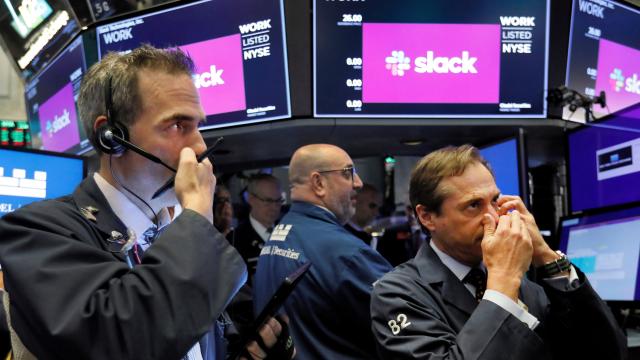In its first day on the New York Stock Exchange, workplace messaging company Slack leapt over 50 per cent above its reference price of $US26 ($38) per share despite employing an unusual, less costly strategy to debut on the market. The past few hours of trading have sent Slack’s total value soaring to $33 billion, while concurrently making what were, respectively, supposed to be the year’s blockbuster IPOs look like absolute dogshit.
So what was it about Slack’s premier that, as you might have repeatedly read, made it so unusual?
In short, it opted to go public through a ‘direct listing’ rather than the splashy Initial Public Offerings favoured by many growth-hungry tech companies. In this schema, companies aren’t seeking to raise additional capital by creating new shares so much as they’re allowing shareholders (employees and third parties alike) to trade their existing slivers of the company on the open market.
Importantly, with a direct listing, it also dodges the expenses and fees involved with using investment banks as underwriters.
Music streaming service Spotify made waves last year when it opted for the same strategy, and hewed close to its $US132 ($191) per share list price, neither ‘popping’ or crashing as more erratic IPOs have a tendency to do.
That’s, in essence, the trade-off: a direct listing is unlikely to generate the same potential return for investors as an IPO. Lyft’s stock has tanked since its debut though, down about $US12 ($17) per share from its original price. While it’s recovered recently, Uber’s IPO was, by raw dollar losses, the worst-performing in stock market history.
Launched in 2013 by Flickr co-founder Stewart Butterfield, Slack has outlasted competitors HipChat and Campfire but faces growing pressure from similar product offerings from Microsoft, Google, and Facebook.
If facing down three of the biggest tech companies was not enough pressure, Butterfield also considers email to be a rival to Slack—and he believes the balance from that dominant mode of workplace communication will more favourably shift towards chat apps within the next 5 to 7 years.
Slack boasts over 10 million daily active users, and approximately 95,000 paying customers.
For a sect of workers who are more or less chained to a computer all day, Slack has become a ubiquitous piece of software—especially with teams using remote workers who don’t otherwise have an easy option for collaboration; for those working offline, the excitement around Slack’s stock market debut is probably more muted.
It’s difficult to rule out that a considerable factor in the steady drumbeat of coverage around Slack’s stock debut is the fact that newsrooms were early adopters of chat platforms.
It’s fun to clown on the hubris of Uber and Lyft, both of which deserve every bit of derision that comes their way, but ultimately day-one returns don’t say much about Slack’s future on the NYSE.
Its immediate success isn’t likely to buck the trend of the Big Tech IPO (AirBnb, Postmates, and WeWork are all expected to IPO in the near future.)
Slack has raised around $2 billion in funding over the past decade and, like Uber, Lyft, Pinterest, and Spotify, remains unprofitable.
An earlier version of this story claimed Slack had 85,000 paying customers; Slack contends the number is closer over 95,000 and the copy has been changed to reflect that.
